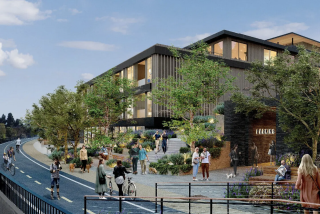Preservation of Historic Buildings
The arguments against preservation of historic buildings given by William C. Baer, associate professor of urban and regional planning at USC (Editorial Pages, May 19) reveal what is wrong with most modern âurban planning.â
Professor Baer begins with the specious statement that Los Angeles should not concern itself with preservation because the city has âlittle heritage of preservation.â Some people might consider that this argument begs the question.
He continues his case against preservationists by saying that âthe very buildings that they seek to preserve today might not have come into existence if we had introduced preservation at an earlier time.â The professor does not seem to grasp the purpose of preservation. When you clean out your closet, you do not save anything but only what is best and most meaningful.
Strangely enough, Baer buttresses his stand against preservation by pointing to the Basilica of St. Peterâs in Rome, a masterpiece of architecture constructed during the sixteenth century. Baer observes that the gardens of Caligula had once occupied the site, followed by Neroâs Circus, and then later an early Christian basilica. The point is, however, that once an edifice had been constructed which was artistically and symbolically meaningful to the people, it has remained essentially unchanged for three centuries. To my knowledge, no one has yet tried to get the gargantuan interior of the church converted to âusableâ office space, or tried to solve Romeâs horrendous parking problem by erecting a multistory parking garage in St. Peterâs Square.
What are the blessings which have been bestowed on us by modern urban development? Should we be grateful for enormous skyscrapers, walls of cement and glass which dwarf human beings in the concrete valleys below? Do we rejoice in look-alike âconvenience centersâ on every street corner, or rows of featureless apartment buildings that contrive to exclude children, old people, cats, dogs, lawns, and gardens?
Frank Lloyd Wright favored clustering office and factory space in tall buildings in order to preserve the surrounding green space and recreational areas. What would he say about the dense modern city in which all sense of human proportion seems to have vanished?
It is true that old buildings sometimes can no longer fulfill their original function. Uses can change; historic homes and buildings have often been converted to schools, administrative centers, theaters, restaurants, museums, and so forth. Occasionally a building can even be moved to a new site. Preservationists are not completely against modern usage, and certainly cannot be made scapegoats for tragedies such as the Los Angeles library fire. Preservationists did not advocate warehousing of valuable books in an unsafe manner while officialdom wrangled and passed the buck for years, even decades.
Many communities have found, however, that restoration of historic areas has resulted in renewed interest in such areas, increased property values, and new influxes of residents, restaurants, businesses, and tourists.
Love of the traditional and the modern are not necessarily mutually exclusive. What is desirable is to have the best, whatever the style or period might be.
Architecture is an art form which involves everyone, since we all work, play, and live in our buildings. As Winston Churchill said, âWe shape our buildings; thereafter they shape us.â It is not preservationists who are the âunwitting enemies of our future,â as Baer says, but those who would exclude all sense of human proportion from our buildings and all sense of tradition from our lives.
JULIA HEARD
Torrance
More to Read
Sign up for Essential California
The most important California stories and recommendations in your inbox every morning.
You may occasionally receive promotional content from the Los Angeles Times.










